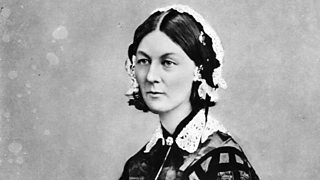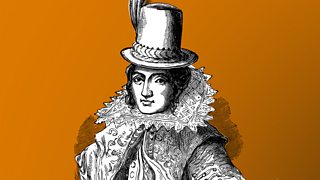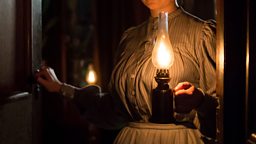Who was the real Florence Nightingale?
Each week Greg Jenner, the brainbox behind Horrible Histories and You’re Dead To Me, has been cramming his brilliant historical knowledge into a lovely little podcast called Â鶹ԼÅÄschool History.
Healthcare workers are close to all of our hearts at the moment, so it makes sense to focus on one particular nursing legend: Florence Nightingale. We know she liked a lamp, but how much do we really know about her?

She had a very unusual name
There weren’t too many Florences around when Miss Nightingale was born in 1820. Her well-to-do family was travelling through Europe when she was born in the Italian city she’s named after. But she might consider herself lucky. Her sister was named after the ancient Greek name for Naples: Parthenope.
She was a clever clogs
Florence’s family, as well as being a bit posh, were also forward thinking and made sure she got a good education, which was pretty unusual for girls at the time. This was handy as Florence was a brilliant scholar, loving science and languages and spending her spare time enjoying unusual hobbies such as coin collecting and seashell study.
She had some unusual pets

Florence's fascinating childhood
A clip from Â鶹ԼÅÄschool History.
Florence displayed her nursing skills at an early age as she was forever looking after injured animals and helping them get well. Over the course of her life she adopted at least 60 cats and believed that small animals, like tortoises, helped hospital patients to recover more quickly. One particular peculiar pet Florence had as a child was a little owl called Athena that she trained to peck her sister when she was annoying her.

She was a rebel
From a young age, Florence knew she wanted to spend her life helping people and decided to become a nurse. At the time, nursing was not seen as the heroic job it is today. In Florence’s time nurses were thought to be dirty, common and even drunkards. Her family were horrified that she didn’t want to settle down and get married, but the strong-willed Florence turned down many marriage requests, knowing that her calling was to help the sick.
She could be very strict
Florence trained to be a nurse and was soon promoted to be more of a nursing manager, organising all the other nurses working under her. When she read about the Crimean War, where England and France fought Russia, and the terrible conditions of the healthcare there, she knew she had to help. She arrived in 1854 and immediately set about cleaning up the filthy hospitals where the unhygienic conditions were killing more soldiers than the battlefield. But even though these field hospitals needed all the help they could get, Florence would send home any nurses she felt weren’t good enough – eventually losing about half her staff.
She was called some pretty strange nicknames
Even though she helped to clean up these dirty military hospitals and save lives, the people in charge weren’t big Florence fans. The bigwigs running the army didn’t like to be told what to do, especially by a woman. They gave her mocking nicknames like ‘The Bird’ and ‘The Petticoat Imperieuse’ meaning a big bossy boots! But Florence wasn’t bothered by this petty behaviour.
She was a media sensation
Even though the people in charge of the military didn’t appreciate Florence, the injured soldiers did and stories about her heroism and caring attitude were sent back home. Soon the newspapers started to take an interest. A famous story about Florence featuring the iconic image of her with her famous lamp appeared in the Illustrated London News and made her very famous.
She hated being a celebrity
But Florence didn’t like all this attention. She shunned the spotlight and when she returned home after the war she would use the fake name ‘Miss Smith’ in order to avoid her fans. She called all of this unwanted attention ‘fuzz buzz’ and distanced herself from it. But the more she fought it, the more famous she became. She even had her picture taken with Queen Victoria.
She spent a lot of time in bed
Unfortunately, while serving the injured soldiers in the Crimean War, she contracted something called Crimean Fever, from which she never fully recovered. She would be very ill for the rest of her life and spend most of her time in bed and housebound. But this didn’t stop her passionate drive to help people. While bedridden, she wrote 14,000 letters and responded to every one that was sent to her.
She was a stats whizz
Though known as a nursing reformer, Florence was also brilliant at compiling statistics and presenting them in a way that everyone could understand. She wrote a huge report on the mistakes made during the Crimean War and how things could be changed, using graphs and graphics to make her points clear. In fact she was so good at number juggling that she became the first woman to join the Royal Statistical Society.
She was a pioneer
Florence is remembered as being the most famous nurse in history, but her achievements went much further than this. She started a nurse’s training college that helped educate healthcare workers from around the world. She knew that cleanliness and good nutrition were vital to help sick people get better, and she spread these ideas far and wide. She wrote two important books about improving care in hospitals. And despite her own ill-health, she lived to the ripe old age of 90, dying in 1910. Humble to the very end, she refused a state funeral and is buried in a small Hampshire churchyard, her gravestone simply reading "FN".

What would Florence Nightingale think of Big Data?
Clip from Â鶹ԼÅÄ Ideas.
More from Radio 4
-
![]()
Â鶹ԼÅÄschool History: Florence Nightingale
Join Greg Jenner for a fun homeschool history lesson on the life of Florence Nightingale.
-
![]()
Great Lives: Florence Nightingale
Dr Lucy Worsley, chief curator at Historic Royal Palaces, chooses Florence Nightingale.
-
![]()
Â鶹ԼÅÄschool History Lesson: The Space Race
Strap yourself in, put your helmet on and get ready to blast off.
-
![]()
Who was the real Pocahontas?
Greg Jenner tells the true story of the Native American princess.
















